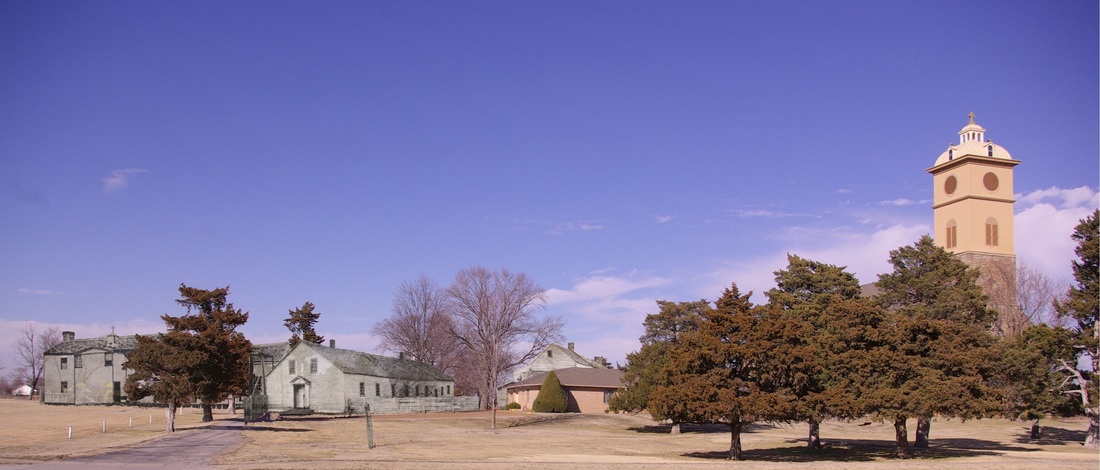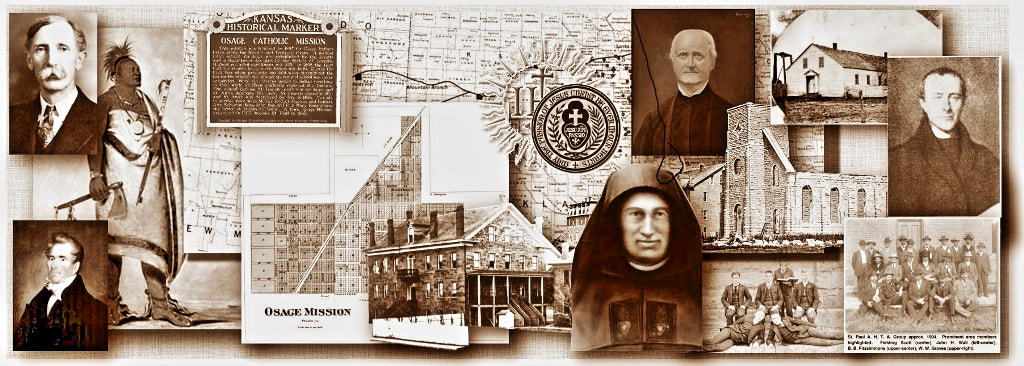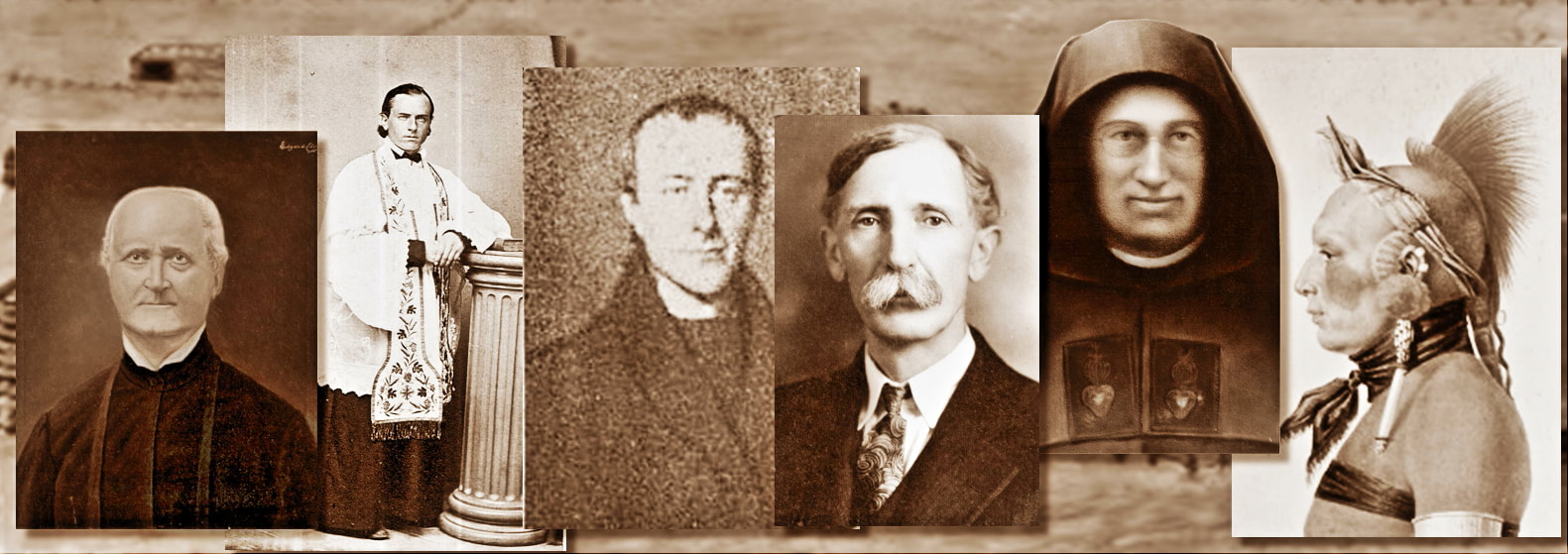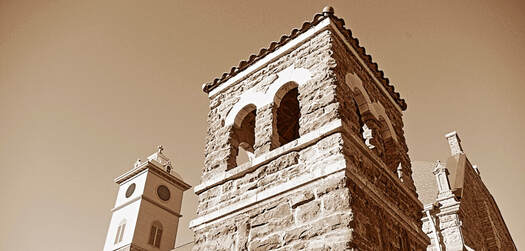“Osage Mission was a great distributing center of civilization in the state because of the nature of its organization, the genius of its missionaries, the accessibility of it location, its long duration and its numerous outposts flung across southern Kansas.”
— Sister Mary Paul Fitzgerald, “Beacon on the Plains”
— Sister Mary Paul Fitzgerald, “Beacon on the Plains”
A Couple of Thoughts:
First — If you have heard an old saying “There’s a lot of history around here”, it certainly applies to St. Paul, Neosho County and the Southern Kansas Region. In fact, the mission story reaches five states. Our Passionist and A.H.T.A. geographical coverage is much larger.
Second — This is not a religious site. “Catholic” discriminates the Catholic Osage Mission from earlier Protestant Osage Missions that were less successful. But with that said, we cannot discount the effect of the long-standing admiration the Osage had for their Jesuit Black Robed priests; and that admiration predated the Mission by well over a century. The relationship among the Osages, the French Traders and the Jesuits led directly to the way our region was settled. The main navigation links below will get you started on a story that goes well beyond that of Osage Mission. Click on the boxes with the descriptions.
First — If you have heard an old saying “There’s a lot of history around here”, it certainly applies to St. Paul, Neosho County and the Southern Kansas Region. In fact, the mission story reaches five states. Our Passionist and A.H.T.A. geographical coverage is much larger.
Second — This is not a religious site. “Catholic” discriminates the Catholic Osage Mission from earlier Protestant Osage Missions that were less successful. But with that said, we cannot discount the effect of the long-standing admiration the Osage had for their Jesuit Black Robed priests; and that admiration predated the Mission by well over a century. The relationship among the Osages, the French Traders and the Jesuits led directly to the way our region was settled. The main navigation links below will get you started on a story that goes well beyond that of Osage Mission. Click on the boxes with the descriptions.
OUR STORY:
The quote above is from the book “Beacon on the Plains” which was the Doctoral thesis of Sister Mary Paul Fitzgerald. Her paragraph packs a lot of meaning into a story that spanned several decades and covered thousands of square miles. But further research, documented by books, memoirs and papers, has shown that our story is larger than her 1939 book [1]. The Osage Mission, St. Paul story goes well beyond southern Kansas and has a much broader timeframe. Click on this illustration for a fifteen-chapter account of OUR STORY. The chapters are brief and can be chosen to suit your time and interest.
The quote above is from the book “Beacon on the Plains” which was the Doctoral thesis of Sister Mary Paul Fitzgerald. Her paragraph packs a lot of meaning into a story that spanned several decades and covered thousands of square miles. But further research, documented by books, memoirs and papers, has shown that our story is larger than her 1939 book [1]. The Osage Mission, St. Paul story goes well beyond southern Kansas and has a much broader timeframe. Click on this illustration for a fifteen-chapter account of OUR STORY. The chapters are brief and can be chosen to suit your time and interest.
CHARACTERS:
A compelling story needs an engaging cast of characters. Sister Fitzgerald’s reference to the Mission’s organization and the genius of its missionaries is only a hint. As remarkable as the Osage Mission missionaries were, there were others, many others, who shaped our story and the stories of other areas around us. Some of those characters were the people who carried on the work of Sister Fitzgerald and others like her. At the top of our list of characters are Osage People who gave us the land our town is on. If that had not have happened, some of our older family’s would not exist. Some of our people, people like me, wouldn’t exist either.
A compelling story needs an engaging cast of characters. Sister Fitzgerald’s reference to the Mission’s organization and the genius of its missionaries is only a hint. As remarkable as the Osage Mission missionaries were, there were others, many others, who shaped our story and the stories of other areas around us. Some of those characters were the people who carried on the work of Sister Fitzgerald and others like her. At the top of our list of characters are Osage People who gave us the land our town is on. If that had not have happened, some of our older family’s would not exist. Some of our people, people like me, wouldn’t exist either.
PLACES:
This is a collection of short articles about places … and other things. It is broken into four categories and the first is a single article that will probably never change. The other three represent a hodge-podge, within groups, that might be useful for local tours, county history or travel planning. For Wild West fans, the hodge-podge includes one notorious Neosho County lynching — maybe another later.
This is a collection of short articles about places … and other things. It is broken into four categories and the first is a single article that will probably never change. The other three represent a hodge-podge, within groups, that might be useful for local tours, county history or travel planning. For Wild West fans, the hodge-podge includes one notorious Neosho County lynching — maybe another later.

Follow this link and "Like" our Facebook page for website updates and other information. Facebook @CatholicOsageMission.
Illustrations:
- The illustration at the top of the page is photo edited from several sources. It depicts three of the ten Catholic Mission buildings in their approximate positions, relative to the church and rectory, from 1847 until the early 1870's. The Osage Manual Labor School for Girls, at the right, is out of perspective. Refer to "The Mission Complex" for more information. Historical photos were scanned from the files of the Osage Mission - Neosho County Historical Society. Base photo of the existing church and rectory and photo editing was done by R. Brogan. Take a look at "5. The Catholic Osage Mission" and its three sub-links for more information about the founding of the Mission.
- The remaining photos were taken or edited by A Catholic Mission.

The Osage Manual Labor School for Girls, visible above the rectory roof, is out of perspective. It sat on an east-to-west orientation in alignment with the boy's school at left. But the image does represent the approximate location of three of the main Mission buildings relative to the rectory and church.



